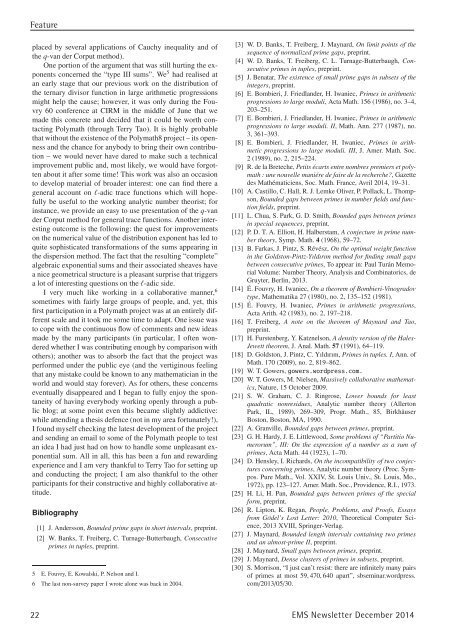2014-12-94
2014-12-94
2014-12-94
You also want an ePaper? Increase the reach of your titles
YUMPU automatically turns print PDFs into web optimized ePapers that Google loves.
Featureplaced by several applications of Cauchy inequality and ofthe q-van der Corput method).One portion of the argument that was still hurting the exponentsconcerned the “type III sums”. We 5 had realised atan early stage that our previous work on the distribution ofthe ternary divisor function in large arithmetic progressionsmight help the cause; however, it was only during the Fouvry60 conference at CIRM in the middle of June that wemade this concrete and decided that it could be worth contactingPolymath (through Terry Tao). It is highly probablethat without the existence of the Polymath8 project – its opennessand the chance for anybody to bring their own contribution– we would never have dared to make such a technicalimprovement public and, most likely, we would have forgottenabout it after some time! This work was also an occasionto develop material of broader interest: one can find there ageneral account on -adic trace functions which will hopefullybe useful to the working analytic number theorist; forinstance, we provide an easy to use presentation of the q-vander Corput method for general trace functions. Another interestingoutcome is the following: the quest for improvementson the numerical value of the distribution exponent has led toquite sophisticated transformations of the sums appearing inthe dispersion method. The fact that the resulting “complete”algebraic exponential sums and their associated sheaves havea nice geometrical structure is a pleasant surprise that triggersa lot of interesting questions on the -adic side.I very much like working in a collaborative manner, 6sometimes with fairly large groups of people, and, yet, thisfirst participation in a Polymath project was at an entirely differentscale and it took me some time to adapt. One issue wasto cope with the continuous flow of comments and new ideasmade by the many participants (in particular, I often wonderedwhether I was contributing enough by comparison withothers); another was to absorb the fact that the project wasperformed under the public eye (and the vertiginous feelingthat any mistake could be known to any mathematician in theworld and would stay forever). As for others, these concernseventually disappeared and I began to fully enjoy the spontaneityof having everybody working openly through a publicblog; at some point even this became slightly addictive:while attending a thesis defence (not in my area fortunately!),I found myself checking the latest development of the projectand sending an email to some of the Polymath people to testan idea I had just had on how to handle some unpleasant exponentialsum. All in all, this has been a fun and rewardingexperience and I am very thankful to Terry Tao for setting upand conducting the project; I am also thankful to the otherparticipants for their constructive and highly collaborative attitude.Bibliography[1] J. Andersson, Bounded prime gaps in short intervals, preprint.[2] W. Banks, T. Freiberg, C. Turnage-Butterbaugh, Consecutiveprimes in tuples, preprint.5 E. Fouvry, E. Kowalski, P. Nelson and I.6 The last non-survey paper I wrote alone was back in 2004.[3] W. D. Banks, T. Freiberg, J. Maynard, On limit points of thesequence of normalized prime gaps, preprint.[4] W. D. Banks, T. Freiberg, C. L. Turnage-Butterbaugh, Consecutiveprimes in tuples, preprint.[5] J. Benatar, The existence of small prime gaps in subsets of theintegers, preprint.[6] E. Bombieri, J. Friedlander, H. Iwaniec, Primes in arithmeticprogressions to large moduli, Acta Math. 156 (1986), no. 3–4,203–251.[7] E. Bombieri, J. Friedlander, H. Iwaniec, Primes in arithmeticprogressions to large moduli. II, Math. Ann. 277 (1987), no.3, 361–393.[8] E. Bombieri, J. Friedlander, H. Iwaniec, Primes in arithmeticprogressions to large moduli. III, J.Amer.Math.Soc.2 (1989), no. 2, 215–224.[9] R. de la Breteche, Petits écarts entre nombres premiers et polymath: une nouvelle maniére de faire de la recherche?, Gazettedes Mathématiciens, Soc. Math. France, Avril <strong>2014</strong>, 19–31.[10] A. Castillo, C. Hall, R. J. Lemke Oliver, P. Pollack, L. Thompson,Bounded gaps between primes in number fields and functionfields, preprint.[11] L. Chua, S. Park, G. D. Smith, Bounded gaps between primesin special sequences, preprint.[<strong>12</strong>] P. D. T. A. Elliott, H. Halberstam, A conjecture in prime numbertheory, Symp. Math. 4 (1968), 59–72.[13] B. Farkas, J. Pintz, S. Révész, On the optimal weight functionin the Goldston-Pintz-Yıldırım method for finding small gapsbetween consecutive primes, To appear in: Paul Turán MemorialVolume: Number Theory, Analysis and Combinatorics, deGruyter, Berlin, 2013.[14] É. Fouvry, H. Iwaniec, On a theorem of Bombieri-Vinogradovtype, Mathematika 27 (1980), no. 2, 135–152 (1981).[15] É. Fouvry, H. Iwaniec, Primes in arithmetic progressions,Acta Arith. 42 (1983), no. 2, 197–218.[16] T. Freiberg, A note on the theorem of Maynard and Tao,preprint.[17] H. Furstenberg, Y. Katznelson, A density version of the Hales-Jewett theorem, J. Anal. Math. 57 (1991), 64–119.[18] D. Goldston, J. Pintz, C. Yıldırım, Primes in tuples. I, Ann. ofMath. 170 (2009), no. 2, 819–862.[19] W. T. Gowers, gowers.wordpress.com.[20] W. T. Gowers, M. Nielsen, Massively collaborative mathematics,Nature, 15 October 2009.[21] S. W. Graham, C. J. Ringrose, Lower bounds for leastquadratic nonresidues, Analytic number theory (AllertonPark, IL, 1989), 269–309, Progr. Math., 85, BirkhäuserBoston, Boston, MA, 1990.[22] A. Granville, Bounded gaps between primes, preprint.[23] G. H. Hardy, J. E. Littlewood, Some problems of “Partitio Numerorum”,III: On the expression of a number as a sum ofprimes, Acta Math. 44 (1923), 1–70.[24] D. Hensley, I. Richards, On the incompatibility of two conjecturesconcerning primes, Analytic number theory (Proc. Sympos.Pure Math., Vol. XXIV, St. Louis Univ., St. Louis, Mo.,1972), pp. <strong>12</strong>3–<strong>12</strong>7. Amer. Math. Soc., Providence, R.I., 1973.[25] H. Li, H. Pan, Bounded gaps between primes of the specialform, preprint.[26] R. Lipton, K. Regan, People, Problems, and Proofs, Essaysfrom Gödel’s Lost Letter: 2010, Theoretical Computer Science,2013 XVIII, Springer-Verlag.[27] J. Maynard, Bounded length intervals containing two primesand an almost-prime II, preprint.[28] J. Maynard, Small gaps between primes, preprint.[29] J. Maynard, Dense clusters of primes in subsets, preprint.[30] S. Morrison, “I just can’t resist: there are infinitely many pairsof primes at most 59, 470, 640 apart”, sbseminar.wordpress.com/2013/05/30.22 EMS Newsletter December <strong>2014</strong>


